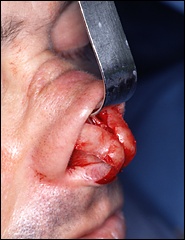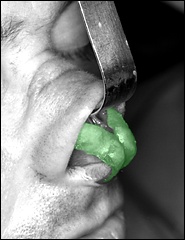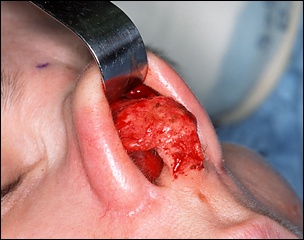
- Incisions

- Hump removal

- Nasal septum

- Tip narrowing

- The nasal bones

- Splint

- Tip support

- Shorten the nose

- The nasal spine

- Revision surgery

- The nasion

- Odd cartilages



|
| Image size: small show larger |
|
|
| Click on any image in this tutorial to see a greatly-enlarged version |

|
|
Also, I don't know what the cartilages in this nose look like yet. If I did, I could picture them underneath the scar, and be extra careful when I thought I had dug down far enough to be close to the cartilage surface. But some of the cartilages were undoubtedly removed in the previous operation, so I don't know what shape the remaining cartilage has, or even if there is any left. As you'll see later in this chapter, cartilage trimming during a poor rhinoplasty can be random and haphazard. And the previous written operation report, if one is available, is rarely of assistance. It is much easier to dictate words related to nasal surgery than it is to perform the operation with skill. Frequently, a terrible rhinoplasty will be accompanied by an immaculate, organized, professional-sounding operation report. The rhinoplasty operation is much, much more difficult than a face lift or eyelid surgery or any other cosmetic operation that a plastic surgeon performs, because everyone's nose is so different and there are so many techniques that the surgeon needs to have at his fingertips to select judiciously and carry out skillfully. Revision rhinoplasty is even far more difficult than primary rhinoplasty ("primary" rhinoplasty means "first time" rhinoplasty). Fighting through the scar tissue you see above, locating what remains of the cartilage structure of the nose without damaging it further, and being able to reconstruct the inside to yield a satisfactory appearance to the nose can be extremely difficult, even in the best of hands. |
| Clear all red checks in the Rhinoplasty Tutorial |